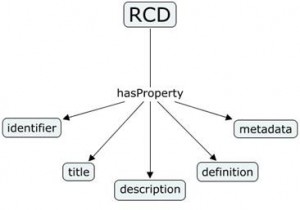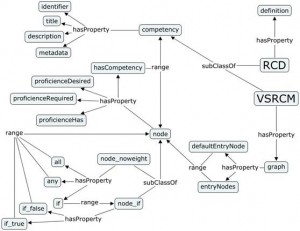This blog post is the first in a series of blog posts about competency map / mapping. You will be able to find them through the tag “competency maps” on my site. The material is primarily taken from my thesis (work done through the TRACE project together with Prof Keith Baker and Prof Shirley Williams), and you are encourage to find it in there. This is “merely” a taster…
Competencies are a “funny” concept – a made up concept – to describe something about people, learning / courses outcome, job requirements etc. There are many different definitions of them, and there are much confusion about what they really mean. I have sat through numerous meeting and conferences where the subtle difference between what a competency and a competence is, and when which should be used. Regarding this, I’m very pragmatic, i.e. I am agnostic to the definition and the difference between ‘y’ and ‘e’ – I usually think of them as synonymous! What I had is a tool which can be used to describe them, no matter the definition, and interrelate them, again, no matter the definition. The user of the tool can do what they like, and therefore follow their own “conviction”.
What I have done though is to follow standards, and set up a system of ontological inference that is very loose – contrary to “normal” ontology tools, which are rigid – and based on a closed world assumption rather than an open world assumption.
The system is based on Reusable Competency Definitions, which is a very simple standard that functions as a wrapper for definitions of competencies, the user decides what that might be. It is an IEEE standard (“Learning Technology Data Model for Reusable Competency Definitions,” New York, IEEE 1484.20.1, 2007.). It has been used as the foundation in other standards, such as HR-XML.
- A unique identifier
- A title
- A description (natural language)
- A definition (a reference to another repository or definition)
- Metadata (further information about a particular competency, this is not limited , it can be any size or format)
The main problem with this standard is that the main parts (title, description and definition) are in human readable form, so if any semantic meaning is to be made available for computers there must be additional knowledge, e.g. attached in the metadata part, connections to other RCDs with metadata or external bindings to other data structures such as ontologies. Furthermore RCDs are only a partial representation of competencies as they are only supposed to define competencies; the evidence, context, dimensions etc. are not included. Evidence is an especially important issue for many competency descriptions, and the RCD therefore needs to be “backed” up by some other material to be able to validate the competencies.
Competency mapping is a technique where different competencies, usually in RCD form, are related to each other with some semantic links. The first real attempt at making a standard for these, as far as I know, was made by Claude Ostyn with his Simple Reusable Competency Mappings (SRCM). The biggest problem with this proposed standard is, in my opinion, that it doesn’t have any way of describing a competency that somebody “has”, but only preferred or necessary competencies, and therefore making it rather difficult to use in real world applications. In my competency suite I created a simplified version of this standard, which included a “has” relation. I called it the VSRCM.
I defined VSRCMs like RCDs consisting of
- A unique identifier
- A title
Optionally it could also have
- A description
- Metadata (further information about a particular competency, this is not limited)
(Note VSRCM does not have a definition section as RCD’s have, the graph provides an improved equivalent functionality.)
Additionally the VSRCM has a graph of nodes with attached competencies. The graph must have at least one entry node (the default entry node).
Each node has properties:
Competency
- RCD
or
- VSRCM (note this could be recursive)
Proficiency (levelling can be user-defined, with support for ontological definitions)
- Required
- Desired
- Current (has)
Relationship to other nodes within the graph:
- All – That is, all the proficiencies of the competencies of the “sub-nodes” need to be “fulfilled” for this relationship to be successful
- Any – That is, one or more of the proficiencies of the competencies of the “sub-nodes” need to be “fulfilled” for this relationship to be successful.
- If (either True or False). This is used to represent alternate proficiencies of competencies, for example a taxi driver based in London is required to have specific knowledge of the area, while a taxi driver elsewhere may only require general map reading.


